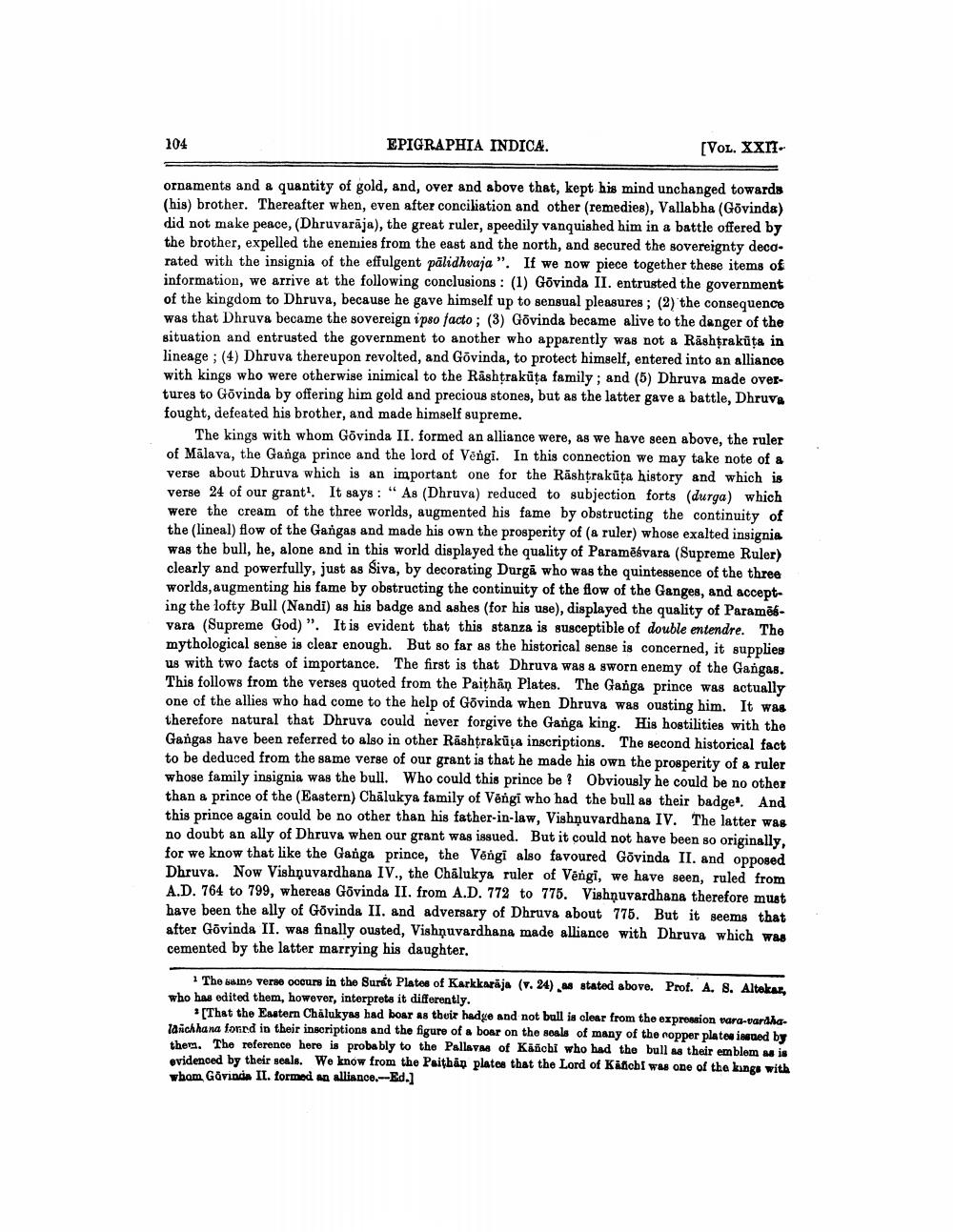________________
104
EPIGRAPHIA INDICA.
[VOL. XXIT
ornaments and a quantity of gold, and, over and above that, kept his mind unchanged towards (his) brother. Thereafter when, even after conciliation and other (remedies), Vallabha (Govinda) did not make peace, (Dhruvarāja), the great ruler, speedily vanquished him in a battle offered by the brother, expelled the enensies from the east and the north, and secured the sovereignty decorated with the insignia of the effulgent pālidhvaja ". If we now piece together these items of information, we arrive at the following conclusions: (1) Govinda II. entrusted the government of the kingdom to Dhruva, because he gave himself up to sensual pleasures ; (2) the consequence was that Dhruva became the sovereign ipso facto; (3) Govinda became alive to the danger of the situation and entrusted the government to another who apparently was not a Rashtrakūta in lineage; (4) Dhruva thereupon revolted, and Govinda, to protect himself, entered into an alliance with kings who were otherwise inimical to the Rashtrakūta family; and (5) Dhruva made overtures to Govinda by offering him gold and precious stones, but as the latter gave a battle, Dhruva fought, defeated his brother, and made himself supreme.
The kings with whom Govinda II. formed an alliance were, as we have seen above, the ruler of Mālava, the Ganga prince and the lord of Vēngi. In this connection we may take note of a verse about Dhruva which is an important one for the Rāshtrakūta history and which is verse 24 of our grant'. It says: “As (Dhruva) reduced to subjection forts (durga) which were the cream of the three worlds, augmented his fame by obstructing the continuity of the (lineal) flow of the Gangas and made his own the prosperity of (a ruler) whose exalted insignia was the bull, he, alone and in this world displayed the quality of Paramēśvara (Supreme Ruler) clearly and powerfully, just as Siva, by decorating Durgā who was the quintessence of the three worlds, augmenting his fame by obstructing the continuity of the flow of the Ganges, and accepting the lofty Bull (Nandi) as his badge and ashes (for his use), displayed the quality of Paramēbvara (Supreme God)". It is evident that this stanza is susceptible of double entendre. The mythological sense is clear enough. But so far as the historical sense is concerned, it supplies us with two facts of importance. The first is that Dhruva was a sworn enemy of the Gangas. This follows from the verses quoted from the Paithān Plates. The Ganga prince was actually one of the allies who had come to the help of Govinda when Dhruva was ousting him. It was therefore natural that Dhruva could never forgive the Ganga king. His hostilities with the Gangas have been referred to also in other Rashtrakūļa inscriptions. The second historical fact to be deduced from the same verse of our grant is that he made his own the prosperity of a ruler whose family insignia was the bull. Who could this prince be ? Obviously he could be no other than a prince of the (Eastern) Chālukya family of Vēngi who had the bull as their badge. And this prince again could be no other than his father-in-law, Vishņuvardhana IV. The latter was no doubt an ally of Dhruva when our grant was issued. But it could not have been so originally, for we know that like the Ganga prince, the Vengi also favoured Govinda II. and opposed Dhruva. Now Vishnuvardhana IV., the Chalukya ruler of Vengi, we have seen, ruled from A.D. 764 to 799, whereas Govinda II. from A.D. 772 to 775. Vishnuvardhana therefore must have been the ally of Govinda II. and adversary of Dhruva about 775. But it seems that after Govinda II. was finally ousted, Vishnuvardhana made alliance with Dhruva which was cemented by the latter marrying his daughter.
1 The suns verse occurs in the Surát Plates of Karkkarāja (v. 24) as stated above. Prof. A. 8. Altekar, who has edited them, however, interprets it differently.
(That the Eastern Chalukyas had boar as their hadge and not bull is clear from the expression vara-vardhaTaichhana foned in their inscriptions and the figure of a boar on the seals of many of the nopper plateinged by them. The reference here is probably to the Pallavn of Kinobi who had the bull as their emblem as is evidenced by their seals. We know from the Paithan plates that the Lord of Kifcbf was one of the kings with whom Gåvinda II. formed an alliance.--Ed.]




